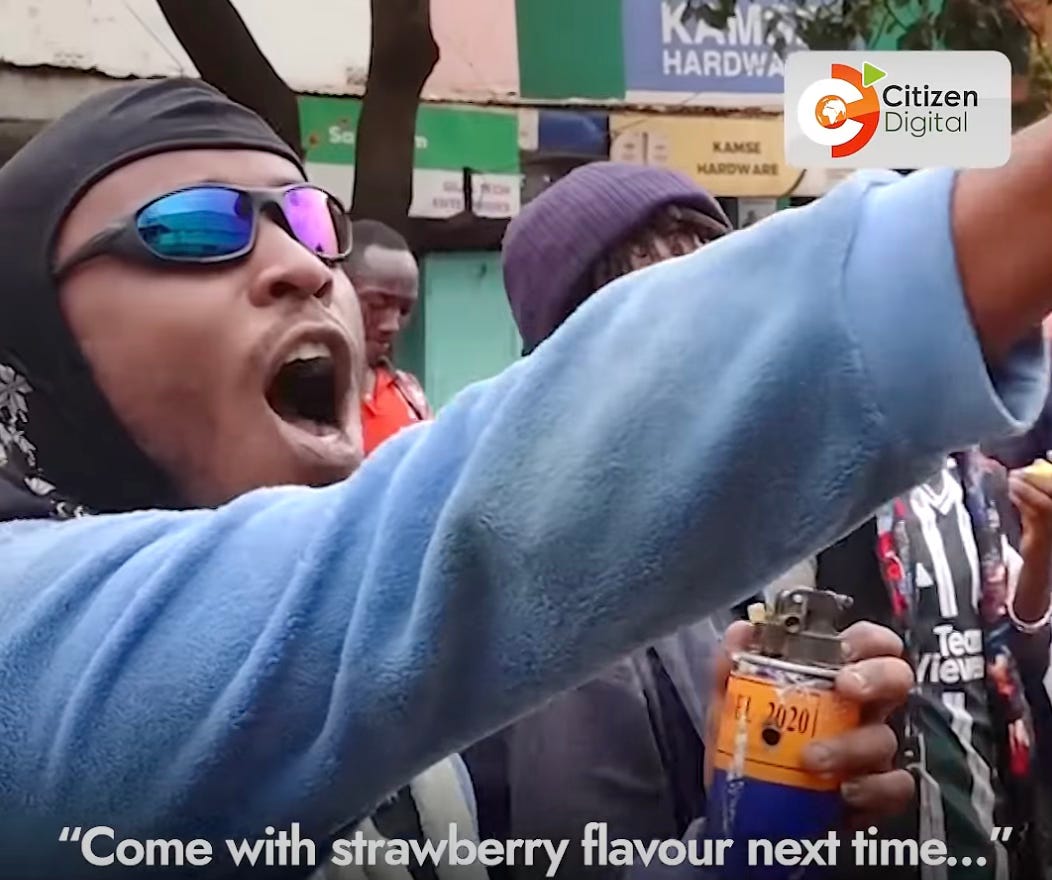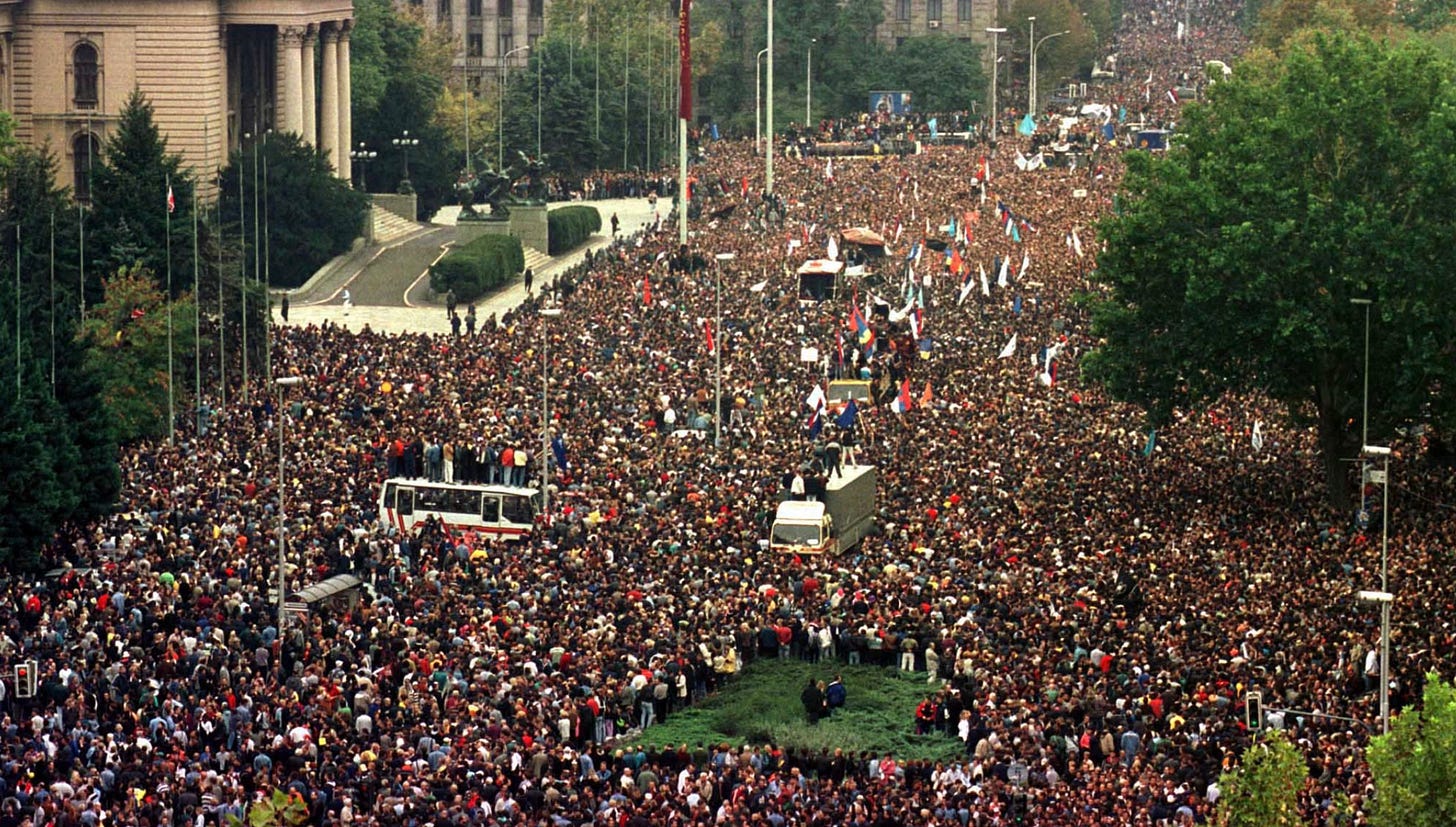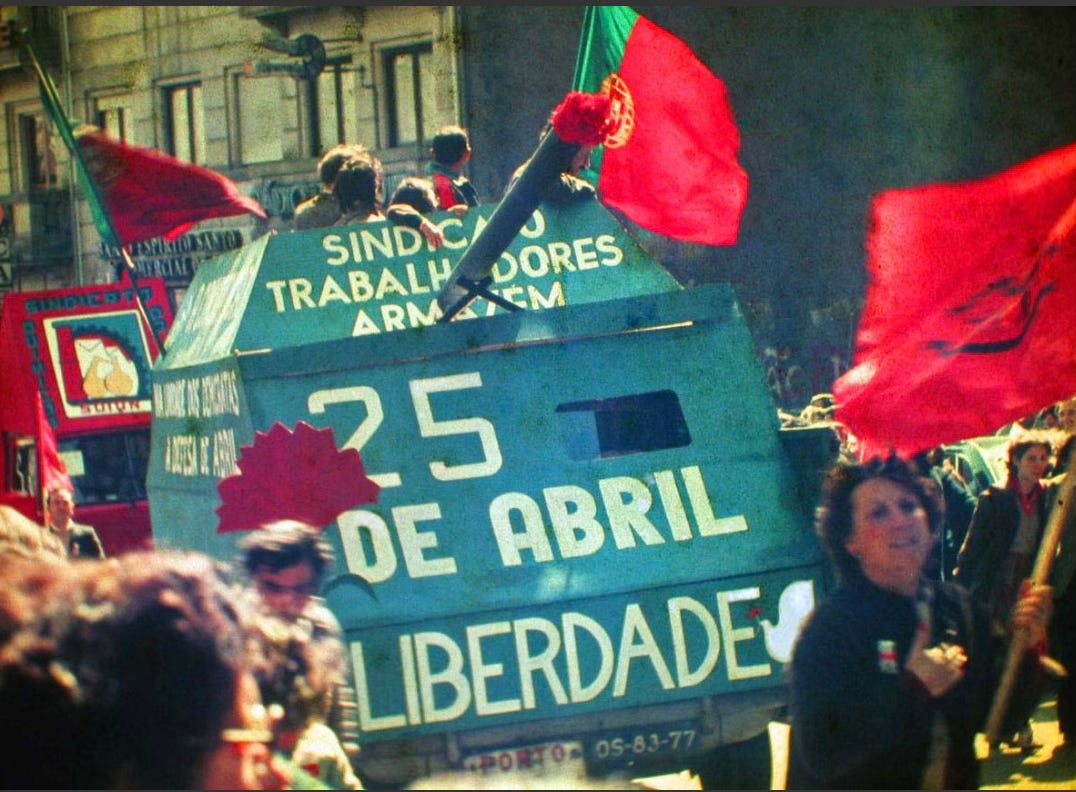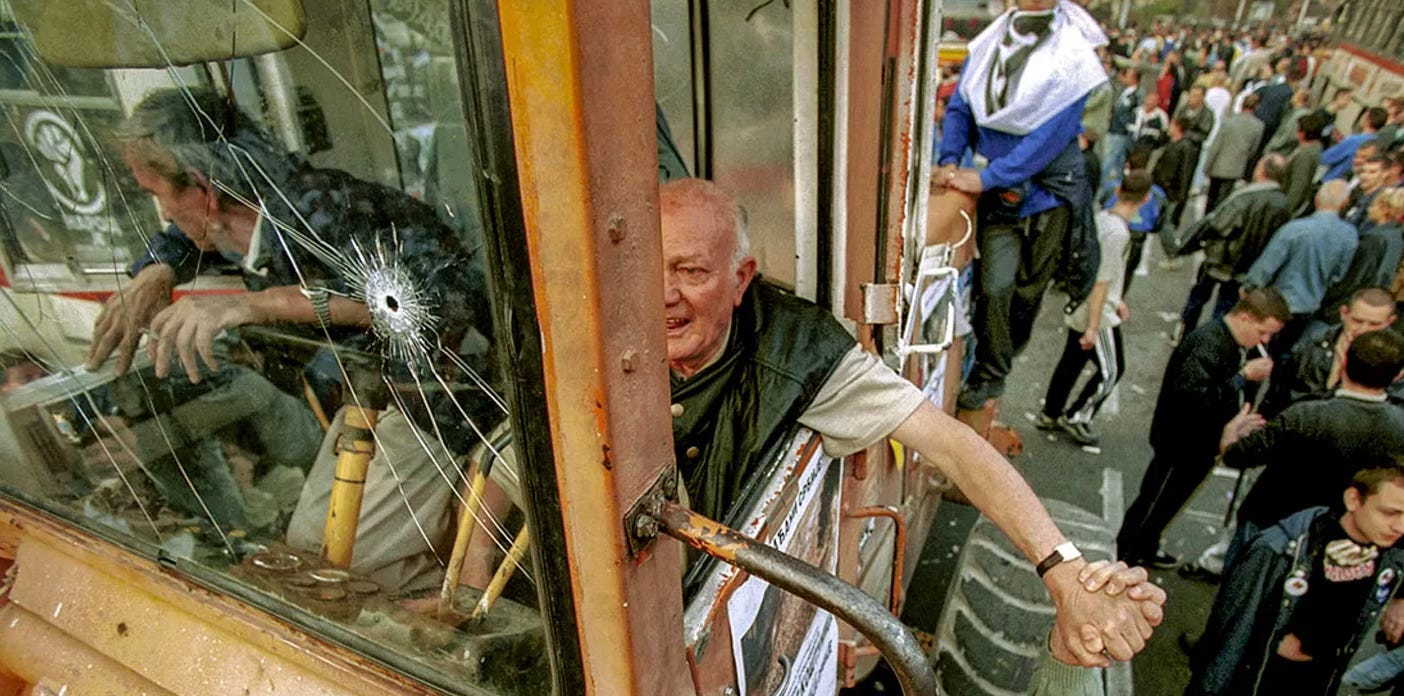“I think we succeeded because we simply loved life more than them…. Those guys were the preachers of death. Their hatred, their propaganda, their language smelled like death. And we won because we loved life more. We decided to love life.”
-Srdja Popovic, Serbian organizer
My apologies to those of you who have heard this one before, but I will never shut up about Ljubisav Đokić1. I am in love with this story, not because Ljubisav Đokić was all that special, but because of his deep and profound unspecialness. Ljubisav Đokić wasn’t a radical activist. He didn’t spend years strategizing how to bring down a dictator. He wasn’t even ideologically aligned with the movement to which he is most famously identified. No disrespect but, like most of us, he wasn’t a particularly brave or remarkable human being. He was just a small business owner who had access to a bulldozer.
To this day, the mass strike that brought down Serbian Dictator Slobodan Milošević is affectionately called the Bulldozer Revolution. That’s a direct reference to Đokić, who rolled into Central Belgrade on October 5th, 2000 with a big old wheel loader and started ramming it into the Milošević-controlled television station. As far as paths to revolutionary iconography go, I get it. Imagine being a student in the streets of Belgrade: facing down armed thugs, wondering if this effort to bring down the dictator might fail, as had so many others in the past. And then, an older conservative man rolls up in a bulldozer, starts bashing away, and directs you to march behind him. And you do, a whole crowd of you. And the soldiers don’t know what to make of all this— yes, the wild man piloting a construction vehicle like he’s the main character in Mad Max Vs. The Balkan Autocrat, but also the re-emboldened masses. There’s something alchemical to it all— powerlessness transformed to power right in front of your eyes. By the end of the day, the dictator resigns and the people win and the protest turns to celebration. You too would look back on the best day of your life and remember the bulldozer.
The problem with stories like that— however true they may be—is that when applied to our own circumstances, it’s easy to imagine them as fairy tales.
I live in the United States, currently a country of downtrodden spirits and pointed fingers. I hesitate to date this essay by explaining the current state of affairs, such is the frenzied pace of change. Rest assured that every day brings a new tranche of Constitutional Crises, each one both dire and stupid at the same time. By the time you read this, Elon Musk and his team of malevolent policy debate teens may still be waging war against mosquito nets, global public health and Lutherans as a general concept. I hear rumors that they will soon move from foreign aid to the Department of Education, a twisted version of “look for the helpers” if ever there was one. Perhaps things will still be bad but in a more conventional American sense (lower capital gains taxes, mostly). Perhaps well-healed left-of-center Americans will have decided that we are not worried about any of this and will have returned to unbothered brunching. Or perhaps there will be heretofore unimaginable abuses of power and common sense. Perhaps Trump will issue tariffs against St. Louis because he mistakenly assumes it is part of France. I can’t and won’t make any predictions.
What I know for certain, though, is that humanity-loving Americans are wont to roll their eyes when we learn about swelling crowds successfully toppling strongmen or rolling back draconian legislation in other countries. We hear about the South Koreans storming the National Assembly this past December— jubilantly and tipsily stopping a coup in its tracks— and we bemoan, “well that can’t happen here, what with a feckless Democratic Party and a cowardly media.” We hear about the Kenyan youths who brought their own authoritarian leader to his knees this past summer, who were so defiant that they turned to the cops and pretended to smoke tear gas canisters, taunting “come with strawberry flavour next time.”2 And once again, our refrain is that all of that’s very nice and inspiring, but it can’t happen here. We aren’t a nation of general strikes, of mass multi-day street protests. We are too spread out and too comfortable. Too many of our neighbors voted for Trump. Too many of our neighbors don’t care. And again, what of our ostensible opposition leaders? How are we to stream into the streets if they’re too milquetoast to do much of anything except issue very concerned statements.

There are counterpoints, of course. Shared revolutionary history is tautological. No country has a history of successfully repelling home-grown autocrats until it actually does so. And who is to say that we in the U.S. are incapable of streaming into the streets, day after day? Don’t we remember the summer of 2020? It was imperfect and incomplete (how could it have been anything but, what with the goal being to undo America’s original sin in a single month?). But still, we were out there. You must remember what that felt like, to see our cities filled beyond comprehension and then to wake up the next morning to find that the crowds had somehow grown even larger. That was us.
I know that lecturing us into collective bravery is a fool’s errand. We’re all too tired for that, myself included. Hopelessness and fear are merely emotions, but emotions create their own reality. We all have extremely persuasive reasons underlying our hopelessness. How are we to stream in the streets if we are too busy, if our bank accounts are empty, if our caregiving responsibilities are too overwhelming, if we ourselves are not safe? We are up against an emboldened Trump and a compliant Congress and Court. We are up against the world’s richest Apartheid-fetishist and millions of our fellow Americans who could act towards us as neighbors but have chosen the siren call of violence and dominance instead. We are up against a reality where farcical Executive Orders are treated as Gospel and resistance is treated as an outdated fad. We are up against maddening but persistent voices repeating that the men in power are Gods and that we are mere mortals.
In moments such as this, I should not harangue you as to why you aren’t already in the streets.
Instead, I will offer this:
The man in the bulldozer only showed up because thousands of others made it easy for him to do so. He showed up because Otpor!, the student organizers who formed that movement’s backbone, had tried and failed at revolution a few years earlier. He showed up because the humbled revolutionaries asked themselves what they needed to do differently, because they refocused on strengthening both their depth and their breadth of connection. They still protested in the interim years, but they worked primarily on building stronger community bonds between committed activists while doubling-down on outreach to sectors of society who didn’t trust them. They organized in hundreds of different ways, such that in the fall of 2000 it wasn’t the students in Belgrade who launched the first protest. It was the miners in Kolubara. Otpar! had built a movement strong enough that in the intervening weeks thousands of Serbians, many who had never identified as activists, joined them in the streets. They built a road to Milošević’s doorstep, such that a bulldozer could deliver the final blow.
We don’t need to be lectured right now on what we’re not doing, but holy cow do we need to build better roads for each other.
What if our job is not to single-handedly topple a government without any back-up, but to make it easier, day-by-day, for more of our neighbors to step farther into the fray? What if that can and must require a wide-range of tactics— that we need the resolute dialers who light up Congressional switchboards, the filers of lawsuits, the weary re-builders of unions, the plaintive senders of “I’m scared, are you too? let’s talk”-texts, the community connectors, the spreadsheet minders, the soup-and-pie-supper-hosters, the permitted-protest-only marchers AND the first glorious few who stick their neck out in more disruptive, civilly disobedient ways? What if we don’t actually need more social media scolds patting themselves on the back for restating how bad it all is, but we do need more people spreading the word about what’s being tried and what seems to be working? What if the opposite of hopelessness is a lane to which we’ve committed, a tactic that we are attempting, ears open not for each new calamity, but for news about what we need from one another?
You can call it magical thinking or a principled reading of history, but I believe that one day, sooner than we can imagine, we too will celebrate in the streets. I’m not naive enough to believe that our celebrations will come before any of us are harmed. My heart breaks daily imagining all the ways that might be true. But I still believe the celebration will come, if only because there is so much that we have not yet tried and built.
I imagine that, like so many other days where the masses have flooded into city streets to celebrate a peoples’ victory, the day of jubilation will bring its own iconography. There might be a bulldozer, or gun barrels stuffed with carnations. Maybe we will sing Tony Orlando songs in unison or remember the first taste of food after our hunger strike under the banyan trees. With any luck, we will hug our friends and tell them how grateful we are that they came out with us.
On that day, we won’t remember what it felt like when we opened the news and found that precious few were taking the first steps of public opposition. We won’t remember when the protests were tiny and the public statements were tepid. We may remember our fear and our grief, but it will live alongside its counterpoint. We will definitely remember our joy. We will remember our laughter. We will remember when we taught each other about the world we could create together.
These are uniquely lonely days, but less because we live in dire times than because we have not yet started building. So let us build, in so many ways. Let us look over our shoulder to learn what kind of building will make it more likely for our neighbors to join us. Let us build and build and build. Let us love building more than we love fear. Let us love each other more than we love our own stasis. Let us love life more than our opponents love death.
End notes:
It’s one thing to tell you to get involved, but I also want to help! Barnraisers winter classes (which are about building the kind of communities that help us fight for a better world) are coming up soon— the first is this Friday. They’re still free and virtual and I’d still love to have you. More info here and registration here.
You all, I know that you’ve got many (very worthy) outstretched hands asking for your assistance right now, but thanks for considering making my work here one of the places you support. Between White Pages and Barnraisers trainings, I do feel like I’m offering perspective and resources that are different from what is available elsewhere, but it does take a lot of work. As always, I appreciate you thinking of me.
If you are wondering “yes, this is all well and good but is anybody already doing something?” I’ve found that the more that I’ve started looking for green shoots of mobilization, the more I’ve found them. AOC went live this week with a decent update on a bunch of efforts. Also, there are currently daily protests in D.C. and Indivisible has done a nice job of putting together “how to yell at your Senator” toolkits (they don’t call them that, but you get the point). Plus, did you know that thousands across the country have already marched against ICE raids (to say nothing of the thousands of ways that individuals and institutions have already stymied ICE in cities across the country)? And that’s just a start. While I’m trying to consciously limit how much time I’m spending on Bluesky and Instagram, I’m committed to sharing more examples/resources for action in both spaces.
One thing I want to acknowledge is that many of you all, no doubt, have to balance your political commitments with the messiness/fullness of life. And oh buddy, I get it. Our household too has been loaded up recently with extra stuff that, although quotidian (in a uniquely America-in-this-moment way) really does build up.3 I mention that not as a “you know who really has it bad? This guy who writes newsletters” flex, but a piece of empathy. We’ve all got a lot of balls in the air, and for some of you those balls are especially cumbersome, and yet we’re trying. Let me know how I can show up for you.
If you’re a South Dakotan or somebody (like me) who holds that state deep in your heart, you know we could use some community-minded new leaders there in a big way. Applications are currently open for the Sutton Leadership Institute and I highly recommend checking it out.
Canadian and Mexican readers. Hi friends! I’m sorry that our countries (were? are?) embroiled in a dumb trade war and that it’s my country’s fault. Here’s one of my current favorite songs from both of your countries (very hard not to pick “Steal My Sunshine” by Len, but I resisted).
That’s “Es-Toy” by Mexican Institute of Sound and “Trucker’s Speed” by Fred Eaglesmith. I’m behind on updating the Song of the Week playlist on Apple Music and Spotify, but they’ll be there in a bit.
Finally, want to look at one more cool Belgrade bulldozer picture? Me too.
Looking back on my archives, I’ve written about my favorite Serbian bulldozer driver twice before— once in 2022 and once in a proto-version of The White Pages in 2019. If you were one of the 100 or so folks who were here for that first essay, you may be entitled to repetition-based compensation from me.
I spent far more time than I’d like to admit getting to the bottom of the whole “did the Kenyan protestor really smoke teargas?” question and thank God it appears the answer is no, because while I love theatrical displays of opposition I’m also pretty sure that teargas remains harmful when inhaled.
I won’t go into too much detail, except to say that when your kid experiences a particularly traumatic code red at school, it sticks with them. And when that same kid is woken up in the middle of the night because somebody has snuck into our back yard to try to steal our cargo bike (they didn’t succeed, thank goodness, as it’s my very on brand go-to form of transportation, but boy did they work that angle grinder), well, you have the kind of night that makes it hard to also metabolize your response to “whatever-it-is-Elon’s doing.” [Ironically tragic update: A few hours after posting this vignette, the beloved cargo bike in question was actually stolen, this time in broad daylight in our neighborhood! Ugh! Totally bummer! Again, there are bigger things going on in the world, but it definitely furthers my point— we’re all shouldering a lot right now while also trying to build a less fascistic world together].








Off topic (but related to the footnote about our last couple days and how everybody's going through something). Remember how I said that the attempt to steal our bike was unsuccessful? Well, today somebody tried to steal our bike in broad daylight and were in fact successful, darn it!
Really cool to hear that background about Otpor!, I love hearing about the movement-building work behind big famous symbolic actions. It's always so important to place those things into a context where tons and tons of people were trying all kinds of different tactics.
The final lines of this poem are rightly quoted a lot, but the whole thing is so good:
Revolutionary Letter #8, Diane di Prima
Everytime you pick the spot for a be-in
a demonstration, a march, a rally, you are choosing the ground
for a potential battle.
You are still calling these shots.
Pick your terrain with that in mind.
Remember the old gang rules:
stick to your neighborhood, don’t let them lure you
to Central Park everytime, I would hate
to stumble bloody out of that park to find help:
Central Park West, or Fifth Avenue, which would you
choose?
//
go to love-ins
with incense, flowers, food, and a plastic bag
with a damp cloth in it, for tear gas, wear no jewelry
wear clothes you can move in easily, wear no glasses
contact lenses
earrings for pierced ears are especially hazardous
//
try to be clear
in front, what you will do if it comes
to trouble
if you’re going to try to split stay out of the center
don’t stampede or panic others
don’t waver between active and passive resistance
know your limitations, bear contempt
neither for yourself, nor any of your brothers
//
NO ONE WAY WORKS, it will take all of us
shoving at the thing from all sides
to bring it down.